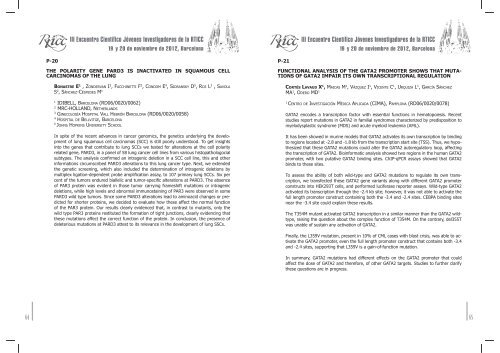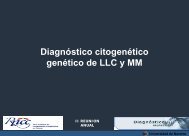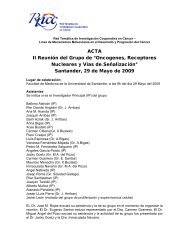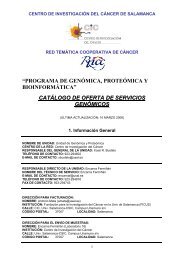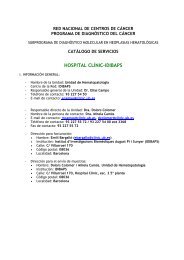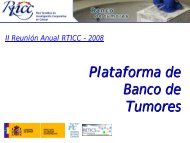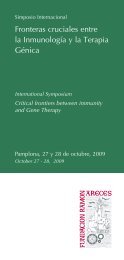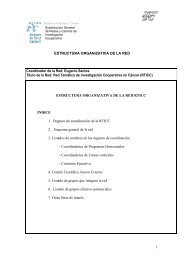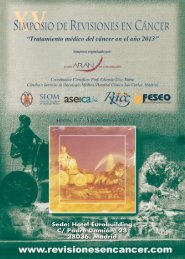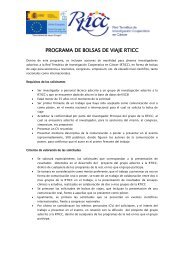Untitled - Red Temática de investigación cooperativa en cáncer
Untitled - Red Temática de investigación cooperativa en cáncer
Untitled - Red Temática de investigación cooperativa en cáncer
You also want an ePaper? Increase the reach of your titles
YUMPU automatically turns print PDFs into web optimized ePapers that Google loves.
P-20<br />
THE POLARITY GENE PARD3 IS INACTIVATED IN SQUAMOUS CELL<br />
CARCINOMAS OF THE LUNG<br />
BONASTRE E 1 , ZONDERVAN I 2 , FACCHINETTI F 3 , CONDOM E 4 , SIDRANSKY D 5 , ROZ L 3 , SAVOLA<br />
S 2 , SÁNCHEZ-CÉSPEDES M 1<br />
1<br />
IDIBELL, BARCELONA (RD06/0020/0062)<br />
2<br />
MRC-HOLLAND, NETHERLANDS<br />
3<br />
GINECOLOGÍA HOSPITAL VALL HEBRÓN BARCELONA (RD06/0020/0058)<br />
4<br />
HOSPITAL DE BELLVITGE, BARCELONA<br />
5<br />
JOHNS HOPKINS UNIVERSITY SCHOOL<br />
In spite of the rec<strong>en</strong>t advances in cancer g<strong>en</strong>omics, the g<strong>en</strong>etics un<strong>de</strong>rlying the <strong>de</strong>velopm<strong>en</strong>t<br />
of lung squamous cell carcinomas (SCC) is still poorly un<strong>de</strong>rstood. To get insights<br />
into the g<strong>en</strong>es that contribute to lung SCCs we tested for alterations at the cell polarity<br />
related g<strong>en</strong>e, PARD3, in a panel of 58 lung cancer cell lines from various histopathologocial<br />
subtypes. The analysis confirmed an intrag<strong>en</strong>ic <strong>de</strong>letion in a SCC cell line, this and other<br />
informations circumscribed PARD3 alterations to this lung cancer type. Next, we ext<strong>en</strong><strong>de</strong>d<br />
the g<strong>en</strong>etic scre<strong>en</strong>ing, which also inclu<strong>de</strong>d the <strong>de</strong>termination of intrag<strong>en</strong>ic <strong>de</strong>letions by<br />
multiplex ligation-<strong>de</strong>p<strong>en</strong><strong>de</strong>nt probe amplification assay, to 107 primary lung SCCs. Six per<br />
c<strong>en</strong>t of the tumors <strong>en</strong>dured biallelic and tumor-specific alterations at PARD3. The abs<strong>en</strong>ce<br />
of PAR3 protein was evi<strong>de</strong>nt in those tumor carrying frameshift mutations or intrag<strong>en</strong>ic<br />
<strong>de</strong>letions, while high levels and abnormal immunostaining of PAR3 were observed in some<br />
PARD3 wild type tumors. Since some PARD3 alterations lead to aminoacid changes or predicted<br />
for shorter proteins, we <strong>de</strong>ci<strong>de</strong>d to evaluate how these affect the normal function<br />
of the PAR3 protein. Our results clearly evi<strong>de</strong>nced that, in contrast to mutants, only the<br />
wild type PAR3 proteins restituted the formation of tight junctions, clearly evi<strong>de</strong>ncing that<br />
these mutations affect the correct function of the protein. In conclusion, the pres<strong>en</strong>ce of<br />
<strong>de</strong>leterious mutations at PARD3 attest to its relevance in the <strong>de</strong>velopm<strong>en</strong>t of lung SSCs.<br />
P-21<br />
FUNCTIONAL ANALYSIS OF THE GATA2 PROMOTER SHOWS THAT MUTA-<br />
TIONS OF GATA2 IMPAIR ITS OWN TRANSCRIPTIONAL REGULATION<br />
CORTÉS LAVAUD X 1 , MAICAS M 1 , VÁZQUEZ I 1 , VICENTE C 1 , URQUIZA L 1 , GARCÍA SÁNCHEZ<br />
MA 1 , ODERO MD 1<br />
1<br />
CENTRO DE INVESTIGACIÓN MÉDICA APLICADA (CIMA), PAMPLONA (RD06/0020/0078)<br />
GATA2 <strong>en</strong>co<strong>de</strong>s a transcription factor with ess<strong>en</strong>tial functions in hematopoiesis. Rec<strong>en</strong>t<br />
studies report mutations in GATA2 in familial syndromes characterized by predisposition to<br />
myelodysplastic syndrome (MDS) and acute myeloid leukemia (AML).<br />
It has be<strong>en</strong> showed in murine mo<strong>de</strong>ls that GATA2 activates its own transcription by binding<br />
to regions located at -2.8 and -1.8 kb from the transcription start site (TSS). Thus, we hypothesized<br />
that these GATA2 mutations could alter the GATA2 autoregulatory loop, affecting<br />
the transcription of GATA2. Bioinformatic analysis showed two regions in the human GATA2<br />
promoter, with two putative GATA2 binding sites. ChIP-qPCR assays showed that GATA2<br />
binds to these sites.<br />
To assess the ability of both wild-type and GATA2 mutations to regulate its own transcription,<br />
we transfected these GATA2 g<strong>en</strong>e variants along with differ<strong>en</strong>t GATA2 promoter<br />
constructs into HEK293T cells, and performed luciferase reporter assays. Wild-type GATA2<br />
activated its transcription through the -2.4 kb site; however, it was not able to activate the<br />
full l<strong>en</strong>gth promoter construct containing both the -3.4 and -2.4 sites. CEBPA binding sites<br />
near the -3.4 site could explain these results.<br />
The T354M mutant activated GATA2 transcription in a similar manner than the GATA2 wildtype,<br />
raising the question about the complex function of T354M. On the contrary, <strong>de</strong>l355T<br />
was unable of sustain any activation of GATA2.<br />
Finally, the L359V mutation, pres<strong>en</strong>t in 10% of CML cases with blast crisis, was able to activate<br />
the GATA2 promoter, ev<strong>en</strong> the full l<strong>en</strong>gth promoter construct that contains both -3.4<br />
and -2.4 sites, supporting that L359V is a gain-of-function mutation.<br />
In summary, GATA2 mutations had differ<strong>en</strong>t effects on the GATA2 promoter that could<br />
affect the dose of GATA2 and therefore, of other GATA2 targets. Studies to further clarify<br />
these questions are in progress.<br />
64 65


